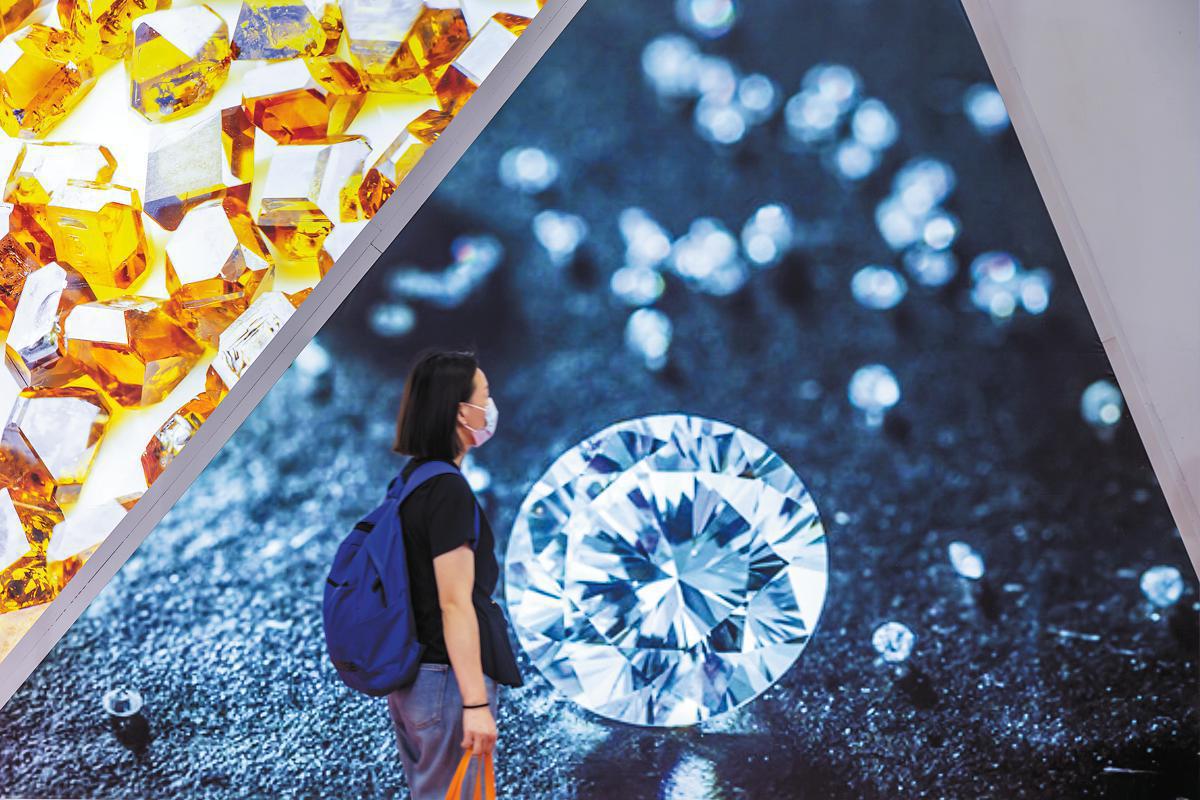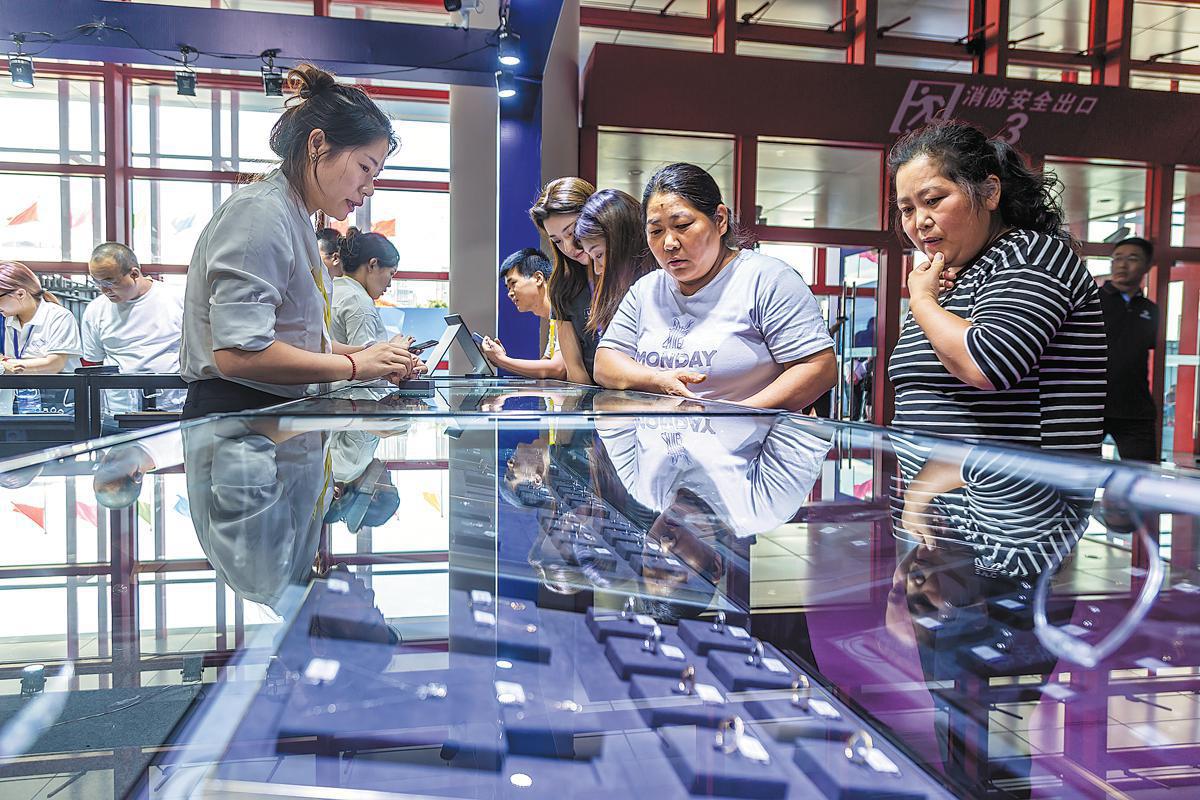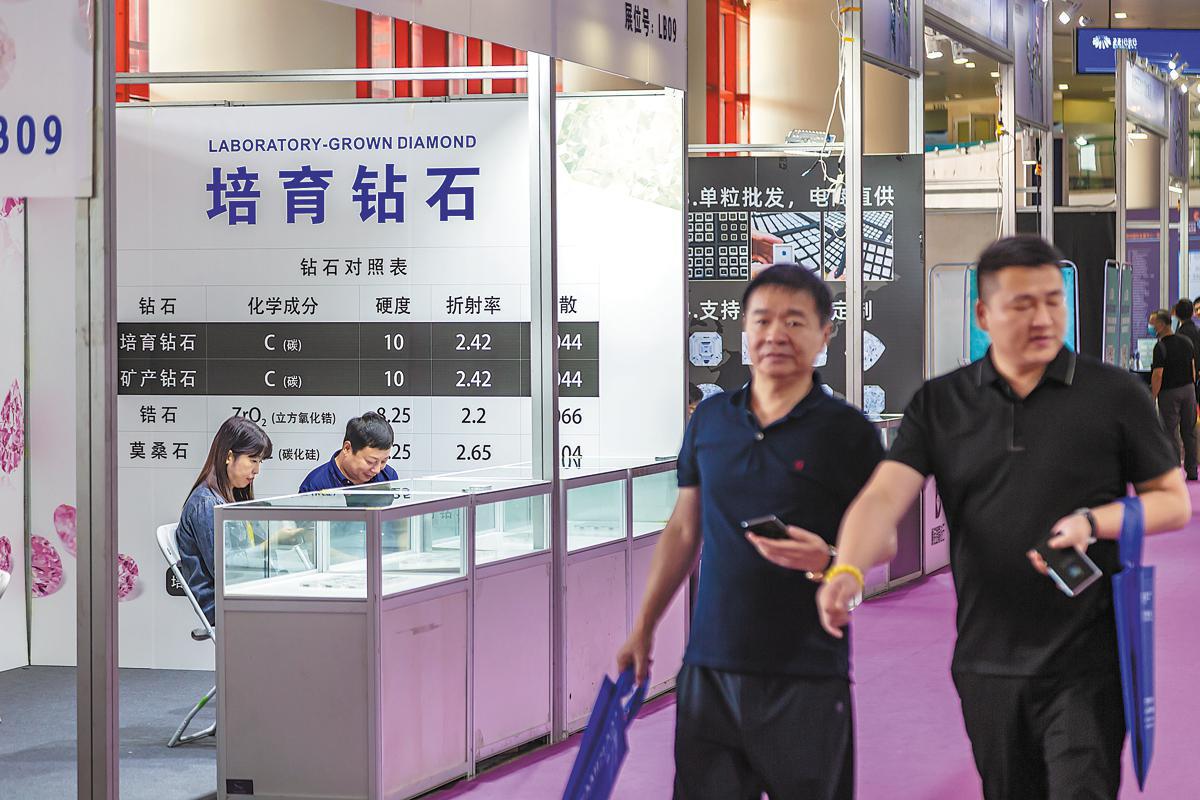Lab-grown diamonds look to dazzle again

Overproduction, fierce competition take glitter away from glamor
Love, embellished with diamonds, does indeed come with a price.
That's what 30-year-old Li Fan was thinking when his fiancee was choosing between an $8,000 1-carat diamond mined from somewhere in Africa and a $700 counterpart grown from a lab in Henan province.
"Whether it be a diamond, a precious metal or a more affordable choice, it appears that you need something to symbolize your commitment to love," he said.
That's also what jewelry dealers are clinging to when they talk about how the market for gem-level lab-grown diamonds will recover from the current sluggish status and how contemporary love stories are more about affordability, cost-effectiveness and environmental consciousness.
Meticulously crafted in laboratories, gem-level lab-grown diamonds mirror the physical, chemical and optical characteristics of their natural counterparts.
Considered an ethical, environmentally friendly and more affordable alternative to traditionally mined gems, gem-level lab-grown diamonds have been growing in favor among Chinese consumers.
In 2019, a lab at the Chinese Academy of Sciences successfully cultivated a gem-level lab-grown diamond and promoted the techniques to companies in Zhecheng county, Henan — a place known for the production of ultra-hard materials including diamonds. Before that, lab-grown diamonds, or synthetic diamonds, were more commonly used as polishing, cutting and drilling tools.
Within two years, Zhecheng witnessed the emergence of two listed companies. In September 2021, Henan Liliang Diamond debuted on the Shenzhen Stock Exchange, followed by Huifeng Diamond on the Beijing Stock Exchange in July 2022. The two companies started as ultra-hard material producers, and found gem-level lab-grown diamonds to be new growth points when expanding production lines.
Sun Ruomei, director of the management committee of Zhecheng's high-tech industrial development zone, said the zone is home to over 110 diamond producing companies with an annual output of 5 billion carats of monocrystalline diamond, among which 4 million carats are gem-level lab-grown diamonds.
By July of this year, about 95 percent of the global production of lab-grown diamonds, also known as synthetic diamonds, came from China, with 80 percent of them produced in Henan, said Sun Zhaoda, secretary-general of the Superhard Material (Industrial Diamond) Association of China.
When it comes to gem-level lab-grown diamonds, data from the Gems and Jewelry Trade Association of China showed China accounted for around 40-50 percent of the global production capacity at 20 million carats last year, making it the world's largest producer.
While the industry is growing rapidly, concerns have arisen as both sales and prices have been declining since last year, leading to profit drops.
Experts said that after two years of explosive development, the industry has seen a surge of manufacturers flood the market, leading to overproduction, which has pushed the industry into price wars and profit losses.
A report from the Gems and Jewelry Trade Association of China revealed that dampened demand in the global market due to a slowing economy, especially in the United States, whose consumption took up about 80 percent of the world's total, has heightened the supply-demand imbalance in China.
Competition from India, the global hub for mined diamond polishing, is also getting fiercer as the country ramps up production of gem-level lab-grown diamonds.

Zhang Dong, head of Sichuan province-based lab-grown diamond business Dofe Story, said currently, there's a market trend that India is gradually increasing imports of raw gem-level lab-grown diamonds and transferring its investment and labor force to lab-grown diamonds from mined gems.
A report by The Times of India said lab-grown diamonds have gained immense popularity due to their technological advancements, increasing consumer awareness and eco-friendly and budget-friendly nature.
The report said India is now the largest producer of lab-grown diamonds that uses chemical vapor deposition technology, and makes up nearly 25 percent of the global production through high-pressure high-temperature technology. CVD and HPHT are two major modalities producing lab-grown diamonds.
"Last year, a 1-carat round lab-grown diamond, classified by the International Gemological Institute as color D or E, VVS in clarity and 3EX in cut, which is close to the highest level of quality, could be sold for around 10,000 yuan ($1,400). The price has been declining since the beginning of this year. In October, a gem of such quality was only priced at around 2,000 yuan in our store in Tangyin county," said Chang Yuan, head of a gem-level lab-grown diamond store in Tangyin county, Anyang, Henan.
"The price can't be lower. Take a 1-carat round diamond classified as D or E color, VVS, and 3EX as an example, the raw diamond costs around 600-700 yuan, polishing for another 600-700 yuan, and there are certification fees, whether it's from IGI or Gemological Institute of America, it costs around 700 yuan," he said.
Chang, 36, has been running the business for about three years. Previously, he was a trade officer at a top-tier ultra-hard material production company in Henan.
"The market for gem-level lab-grown diamonds was really in a boom from 2018 to 2021. A lot of staff members like me, who worked for ultra-hard material companies, started their own businesses to ride the tide. Plenty of traders from India, the United Arab Emirates and the US came to us for raw diamond purchases on a large scale," Chang said.
Gem-level lab-grown diamond businesses of much larger sizes are also affected. In the first half of this year, a top-tier lab-grown diamond producer, Liliang Diamond, revealed a 27.95 percent year-on-year profit decline to 172 million yuan. Its revenue dropped by 19.44 percent to 360 million yuan.
The company explained in its financial report that the revenue decline was due to a significant drop in the selling prices of a major type of product — gem-level lab-grown diamonds.
Henan Huanghe Whirlwind, another major ultra-hard material producer in Henan, reported revenue of about 1 billion yuan in the first half, a year-on-year decline of 21.09 percent. It showed a loss of 219 million yuan during the same period.
The company said in its announcement that its main business, ultra-hard materials and gem-level lab-grown diamonds, experienced a significant price drop in the first half due to market supply and demand changes, resulting in a substantial decrease in the company's main business profit.
The company's gross profit margin dropped from 29.09 percent in the first quarter to 17.95 percent in the second quarter.
Gem-level lab-grown diamonds are also cooling on the global market. The second largest lab-grown diamond producer in the US, M7D Corporation, which trades as WD Lab Grown Diamonds, filed for bankruptcy in October.

Consumer recognition is another reason behind the sluggish market. "To my experience, there are people who might want diamonds from labs, or wherever, but they don't want to tell other people their ring was a few hundred dollars or less, when they need something to brag about," Li said.
A report from Minsheng Securities showed that while 54 percent of consumers would like to buy gem-level lab-grown diamonds to please themselves, more (73 percent of females and over 50 percent of males) were reluctant to use them for engagements or weddings.
"When it came to the second hand market, no collectors want lab-grown diamonds and they are hard to be resold," he said.
While gem-level lab-grown diamonds are anything but popular in the secondhand market, mined diamonds aren't particularly welcomed either. Tang Huan, managing a recycling store in Shenzhen's jewelry hub Shuibei in Guangdong province, said a mined diamond that weighs around 1 carat, F in color and VVS in clarity with a GIA certificate, is priced around 20,000 yuan to 40,000 yuan for recycling, while buyers may pay three times the price, or even higher depending on the brand, to buy a diamond of similar quality.
Despite all, Chang, the business owner from Henan, is upbeat about the market's outlook.
"We observed there's a slight increase in consulting volume from customers and in-store purchases this year, indicating that more consumers are now welcoming the idea of gem-level lab-grown diamonds," Chang said.
"The ups and downs are an inevitable step in the development of an emerging market. The market needs time to wash out dealers who use zircon or other materials to fake gem-level lab-grown diamonds, and those unable to produce high-quality gems or those who can't innovate business models," he said.
Chang said there is an increasing number of businesses that use moissanite and zircon in jewelry items but claim such products to be lab-grown diamonds. "Most of them are sold through online stores, priced less than 200 yuan, which is appealing to consumers who are not familiar with methods to identify lab-grown diamonds, making business for us even harder." He called for further efforts to regulate the market.
"Nevertheless, the market is always there and we believe in meeting consumer needs backed by lab-grown diamonds' cost-effectiveness, increasing consumer awareness and their nature of being both environmentally and budget-friendly. The market is just at an adjustment period challenged by a supply surplus, growing competition from Indian manufacturers and a lack of adequate regulation," he said.
"Development of gem-level lab-grown diamonds is just getting started and needs certain adjustments. Going forward, those who can offer good quality and cost-effective products with innovative business models can ride the waves," Zhang of Dofe Story said.
Contact the writers at liuyukun@chinadaily.com.cn
Invest in China Copyright © 2026 China Daily All rights Reserved
京ICP备13028878号-6
 京公网安备 11010502032503号
京公网安备 11010502032503号





